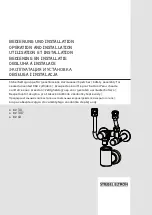
24
Part Number 550-142-320/0720
GWA
Series 3
Gas-Fired Water Boilers –
Boiler Manual
7 Start-up
continued
Check the pilot ignition system used for the
boiler. The boiler model suffix will contain an “I”
for spark-ignited pilot. See
Section 11
for spark-
ignited pilot “Operating Instructions”.
Check burner flame — Pilot burner
Vent damper must be fully open before main
burners light. If vent damper does not fully open,
flue products such as carbon monoxide will
escape into house, causing severe personal injury
or death.
3. Lower thermostat setting — Main burner flames will go out,
then vent damper will close.
4. Repeat Steps 2 through 4 several times to verify operation.
5. Return thermostat to normal setting.
6. Set thermostat heat anticipator setting indicated on wiring
diagram.
Check venting system operation
1. With boiler firing, hold a candle or match below lower
edge of draft hood “skirt.” If flame does not blow out, but
burns undisturbed, the vent system is working properly. If
flame blows out or flickers severely, the vent system must
be checked for obstructions or other causes of improper
venting.
Check vent damper operation
1. Raise room thermostat to call for heat — Vent damper
actuator will slowly open vent damper.
2.
When vent damper is fully open
— Pilot will light, then
allow main burners to ignite.
Proper pilot flame (see Figure 19):
1. Blue flame.
2. Inner cone engulfing pilot flame sensor (spark-ignited pilot).
3. Pilot flame sensor glowing cherry red.
Improper pilot flame:
1. Overfired — Large flame lifting or blowing past pilot flame
sensor.
2. Under fired — Small flame. Inner cone not engulfing pilot
flame sensor.
3. Lack of primary air — Yellow flame tip.
4. Incorrectly heated pilot flame sensor.
Check burner flames — Main burner
Proper main burner flame (
see Figure 20
):
1. Yellow-orange streaks may appear (caused by dust).
Improper main burner flame:
1. Overfired — Large flames.
2. Under fired — Small flames.
3. Lack of primary air — Yellow tipping on flames (sooting will
occur).
Figure 19
Typical pilot burner flame
Verify operation
Figure 20
Typical main burner flame
1. Check system piping for leaks. If found, shut down boiler
and repair immediately.
2. Vent air from system using manual vents. Air in the system
will interfere with circulation and cause heat distribution
problems and noise.
3. Inspect vent system thoroughly for signs of deterioration
from corrosion, physical damage or sagging. Verify that
masonry chimney liners are in good condition, with no
obstructions, and there are no openings into the chimney.
4. Check around the boiler for gas odor following the proce-
dure of “Check for gas leaks”, page 22.
5. Verify operation using procedures below. Perform “Check-
out procedure”, page 25, and fill in the “Installation and
service certificate”.
If boiler doesn’t start . . . Check for:
1. Loose connections, blown fuse or service switch off?
2. Boiler temperature adjustment, set below boiler water
temperature?
3. Thermostat set below room temperature?
4. Gas not turned on at meter or boiler?
5. Incoming gas pressure less than:
5”
w.c. for natural gas? 11” w.c. for propane gas?
6. If none of the above corrects the problem, see
“Troubleshooting”,
Section 13, page 35
.
















































